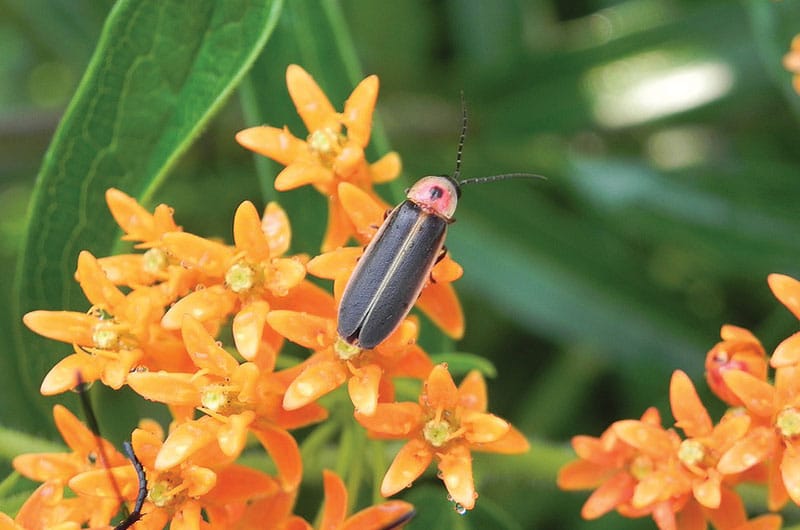by Dr. Sarah Treanor Bois
Director of Research & Education at the Linda Loring Nature Foundation
It’s lightning bug season on Nantucket, and the evening sky is now even more exciting.
Lighting bugs, or fireflies, have been lighting up the evening skies since around the fourth of July (perhaps a friendly competition with the fireworks?). Just after dusk, many have been treated to their own local light show as hundreds of lightning bugs do their best “flash dance” impression. So what’s going on here? Why now? Why so many? And what’s really going on with those light up bottoms?
Fireflies and lightning bugs are common names for a family of beetles called Lampyridae. There are actually more than 150 species of fireflies in North America, and more than 2,000 worldwide. They generally divide into three groups based on how they attract mates. There are those that blink in quick flashes, those with long, slow glows, and those that don’t use light at all, but communicate by other means such as pheromones (chemical signals).
For the “blinkers,” each species “blinks” in a specific pattern, sort of like Morse code, to communicate with others of the same species. At this time of year, they are looking for mates, with the males flying around at dusk flashing specific patterns to attract females. It’s a dramatic love-dance with the firefly abdomen aglow as he searches for a mate. The females, meanwhile, rest on vegetation and generally do not fly. When she sees a male of her own species flashing the correct pattern, she flashes back. In this way, females have their choice of mates. If she doesn’t flash back, he cannot find her. She can literally “throw shade”!
How do they do it? The glow is actually a chemical reaction known as bioluminescence. The lightning bug controls the reaction, and thus the pattern, via its light organ. The release of oxygen controls the reaction, so in the presence of oxygen and other necessary chemicals, the abdomen lights up. Without oxygen, there is no light.
There are three main types of flashing fireflies; Photinus, Pyractomena, and Photuris. There are about 15 species of Photinus fireflies in New England: they are small and produce a yellow-green flash. The Pyractomena fireflies are about the same size but produce an amber flash that looks like a campfire ember. The Photuris fireflies are bigger (about an inch long) with a green flash.
In some parts of the world, fireflies will blink in unison as a group. This is famously seen with tropical fireflies in Southeast Asia. It has also been seen in the Great Smokey Mountains, where people gather every year to see the show. Imagine seeing a sea of green blinking fireflies all in unison! Researchers are not positive about why this happens, but the main hypothesis is that they are attracting mates as a group rather than individually.
Fireflies are associated with summer in New England as this is their mating season and the best time to see them. On Nantucket, they typically appear in late June and early July. While it’s difficult to pinpoint the exact date fireflies will appear every year, researchers know that temperature and precipitation have something to do with it. Fireflies love hot and humid weather, so we can understand why the fireflies have been lighting up Nantucket the past two weeks. It’s one consolation for the humidity!
Weather not only plays a role in the when you see firefly flashes, but how many flashes too. On warm and humid evenings, lightning bugs can light up a field as if it were a Christmas tree! But on cooler nights when air temperatures take a dip into the 50s, don’t be surprised if you wait a minute or longer to see a single flash. Why? Fireflies, like most insects, are cold-blooded (meaning they depend on heat from their surrounding environment to help them function), so their activity peaks when temperatures rise, and slows when temperatures drop.
In many yards across the island, the firefly show has been a treat especially followed by the starry skies; a particular benefit to being 30 miles out to sea. Light pollution in more densely population areas may be a particular threat to fireflies which use light to communicate. The same light pollution affects star-gazing as well.
Pesticide use, habitat destruction, as well as light pollution have taken their toll on fireflies throughout their range. Because they are so charismatic and easy to observe, the Massachusetts Audubon Society is spearheading the citizen science program, Firefly Watch. Along with researchers from Tufts University, this project was started in 2008 and uses citizen observations to help learn more about firefly geographic distribution and population patterns.
If you are interested in participating or learning more about this program, check out massaudubon.org/get-involved/citizen-science/firefly-watch. All you need to do is spend 10 minutes once a week during firefly season observing fireflies in your area. All observations (even “no data) are valuable!
Fireflies around your yard are not only a fabulous evening light show, they help control other insect pests. As larvae, they are predatory and eat other insects, snails, and worms. As adults, they may eat other insects, but mainly feed on plant nectar. To attract fireflies (and other beneficial insects) to your yard, limit or restrict pesticides as well as the wattage of outside light.
It’s best to observe lightning bugs just after dusk. With a little practice, you can learn to recognize many fireflies by their flash patterns. Firefly Watch also has good information on how to differentiate between species based on flash patterns.
Because lightning bugs communicate with light, please don’t shine flashlights or other bright lights near them. It will confuse them and interfere with their nightly routine and possibly their mating chances!


